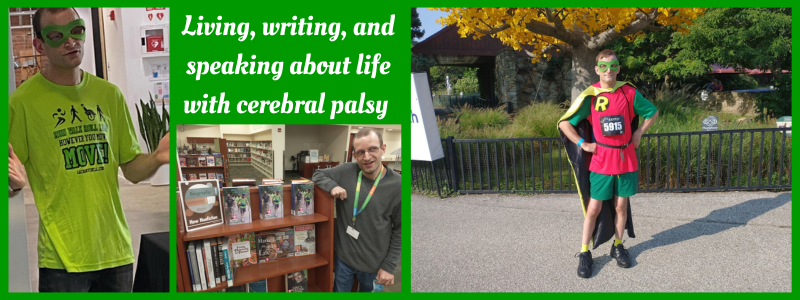Think about the last time you said “I can’t.” What couldn’t you do? Why? Answering these questions will most likely lead to a discussion on limits. Who set said limits? The dialogue continues! Allow me to ask one more question. When did you last challenge your limits?
Others in the cerebral palsy community helped me to see the importance to challenging limitations. In fact I became engaged with today’s topic a couple weeks back during the July #CPChatNow Google Hangout. The social media movement #CPChatNow I run with Reaching for the Stars Student Ambassador Blake Henry hosts a video chat once a month via Google Hangouts.
Anyways as the video chat progressed I came to ask “What are our true limitations?” To illustrate what I meant I referenced cerebral palsy memoir Someone Like Me: An Unlikely Story of Challenge and Triumph Over Cerebral Palsy by John W. Quinn (read my review here). Keeping his condition a secret John served 20 years in the U.S. Navy. Upon retiring John held the Navy’s second highest rank, that all only happened because John decided to challenge his limits.
 You see the first time John went to take the physical to get into the Navy he failed. The duck-walk gave him fits. Rather than accepting the limitation his body decreed on him “I can’t duck-walk” John spent one year working on the duck-walk. He challenged his limitation and spoiler alert, he passed the duck-walk the second time around.
You see the first time John went to take the physical to get into the Navy he failed. The duck-walk gave him fits. Rather than accepting the limitation his body decreed on him “I can’t duck-walk” John spent one year working on the duck-walk. He challenged his limitation and spoiler alert, he passed the duck-walk the second time around.
Funny in my latest impression video designed to raise cerebral palsy awareness I mention John’s book Someone Like Me. Channeling legendary pitchman Billy Mays I say in-part “(John) will inspire you and make you realize that there are things you can do that you never thought you could do.” His duck-walk story provides just one example.
A less high profile case demonstrating the possibilities when you challenge your limits comes from #CPChatNow’s own Erin Diericx. Back in June Erin led us in a focused Twitter chat about exercise. She shared her long-term goal to stand unassisted for five minutes and short-term goal to stand unassisted for two minutes. Goals which leave Erin like John challenging limitations.
While both Erin and John demonstrate challenging physical limitations, the limitations you need to challenge may manifest themselves differently. For instance after a long productive day I will often sit at my laptop ready to shut down my system and go to bed. Instead I lay out an internal challenge, “One more hour.” Essentially I’m challenging the limits to my willpower.
To draw everything to a conclusion, let us return to the post’s initial proposition. “Think about the last time you said ‘I can’t.’” Now answer, how will you challenge your limits so “You can’t” becomes “You can?” Perhaps you could even leave your answer in the “Comments” section below.




